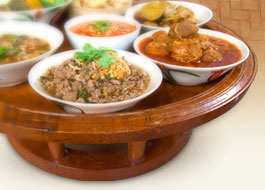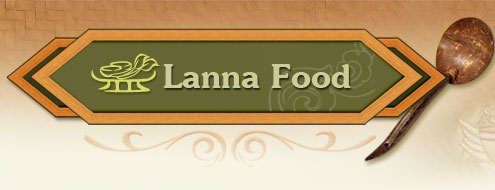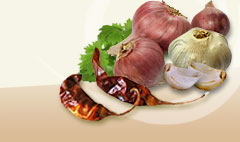Tamarind |
|
|
 | Tamarindus Indica Linn |
|
| |
 | Leguminosae-caesalpinioideae |
|
| |
 | Tamarind |
|
| |
 | Ba kham (Northern), mak kaeng (Mae Hong Son), talup (Nakhon Si Thammarat), am-phian (Surin), mak kradan, makham khi maeo (Kanchana Diwiset, et al., 2005, p. 171) |
|
| |
 | Tree, branching at the top, very strong, approximately 60 ft. high, brown bark with fissures. Leaves pinnate, 10-18 pairs, oblong-linear, unequal, mucronate, glabrous, dark green. Inflorescence of small racemes, 10-15, yellowish-orange. Pod oblong, curved, brown with a fibrous, pulpy mesocarp; seeds obovate-orbicular, compressed, shiny dark brown. (Kanchana Diwiset, et al., comp., 2005, p. 171) |
|
| |
 |

100 gm. of the young leaves have 78 kilocalories energy, fat 1 gm., carbohydrates 16.1 gm., protein 5.1 gm., fiber 1.3 gm., Vitamin C 24 mg., phosphorus 52 mg., Vitamin A 4.183 IU, Vitamin B1 0.1 mg., Vitamin B2 0.11 mg., Vitamin C 6 mg., no niacin (Maprang, 2005, p. 108). The young leaves have a sour taste and are usually added to tom yam and tom Khlong, tender pods are made into namphrik makham. Flesh of mature makham is used in kaeng som and kaeng khua. (Kanchana Diwiset, et al., comp., 2005, p. 171) Mature pods enhance the flavor of cho phak kat. When ripe the pulp is referred to as makham piak and added to enhance the flavor of kaeng bon. |

Mature leaves: expectorant, purifies the blood and relieves gas in the intestines, treats dysentery and coughing. The liquid is used to soak a childs head with to rid him of a cold.
The fruit pulp serves as an expectorant, laxative, thirst quencher. It is mixed with lime water and given to a mother who has just given birth to drink (sometimes with a little salt to expel the placenta and to clean the uterus.
Seeds are eaten to expel worms and used as a laxative.
The pod fiber is anti-diarrhea.
The bark is also a febrifuge and astringent. It also relieves swollen gums and toothaches.
The wooden core is an expectorant and reduces blood pressure.
(Wut Wuthithamwet, 1997, p. 345)
|
|
| |
 | Rainy season and winter |
|
| |
 |
Kanchana Diwiset, et al., comp. (2005). Phak Phuen Ban Phak Nuea. Phennapha Sapcharoen, ed. (2nd ed). Nonthaburi: Center for Text Development of Traditional Thai Medicine. (inthai). Maprang. (2005). Khunkha Phak Khue Ahan Lae Ya Ayuwatthana. Bangkok: Phailin. (inthai). Wut Wuthithamwet. (1997). Saranukrom Samunphrai: Ruam Lak Phesatchakam Thai. Bangkok: Odean Store. (inthai). |
|
| |
|
|




